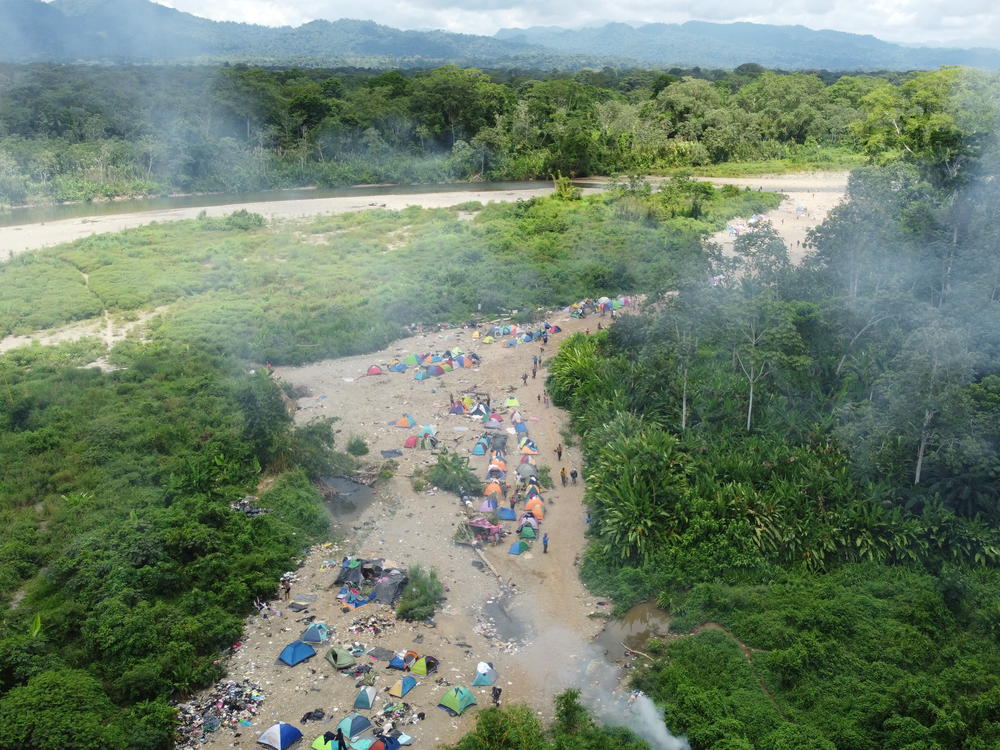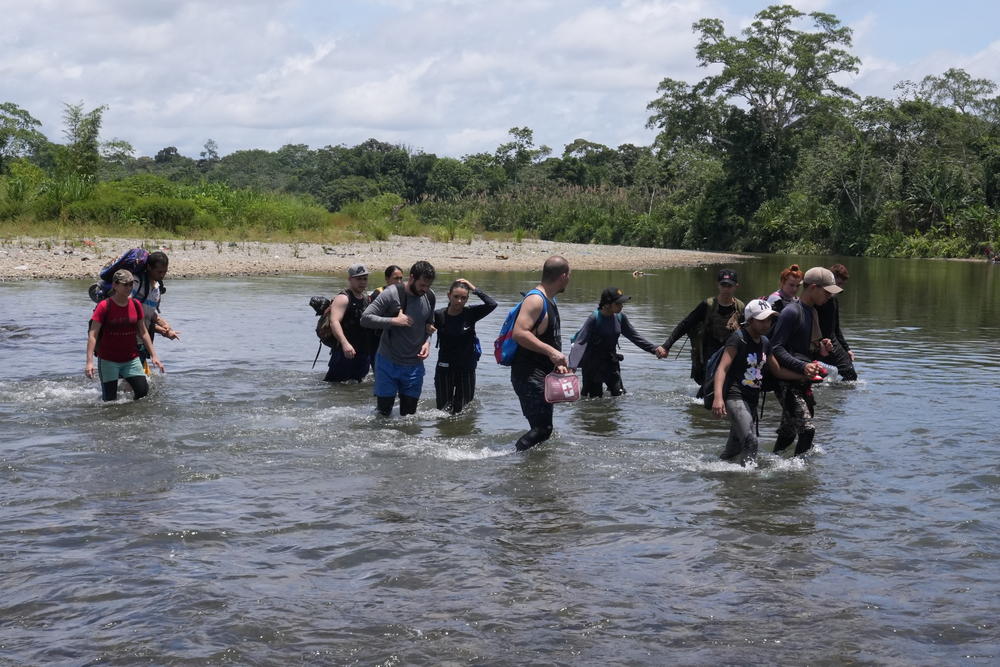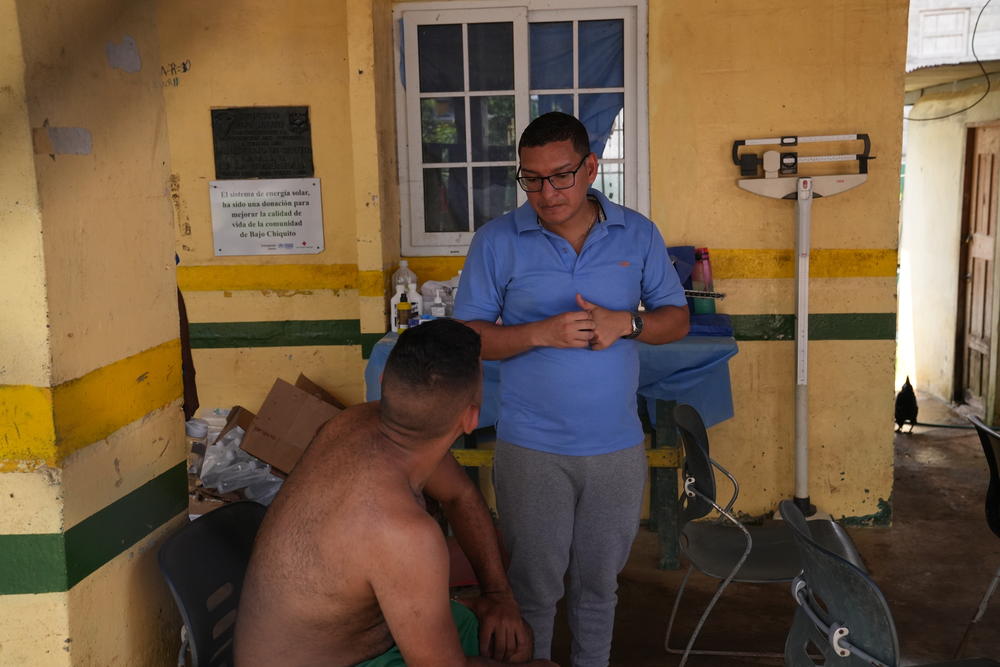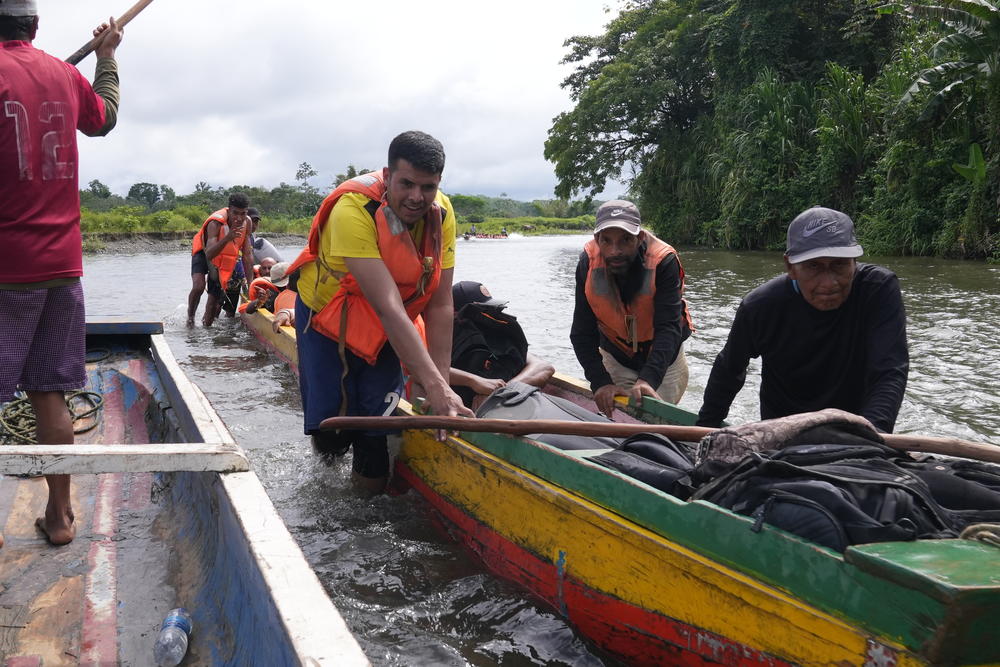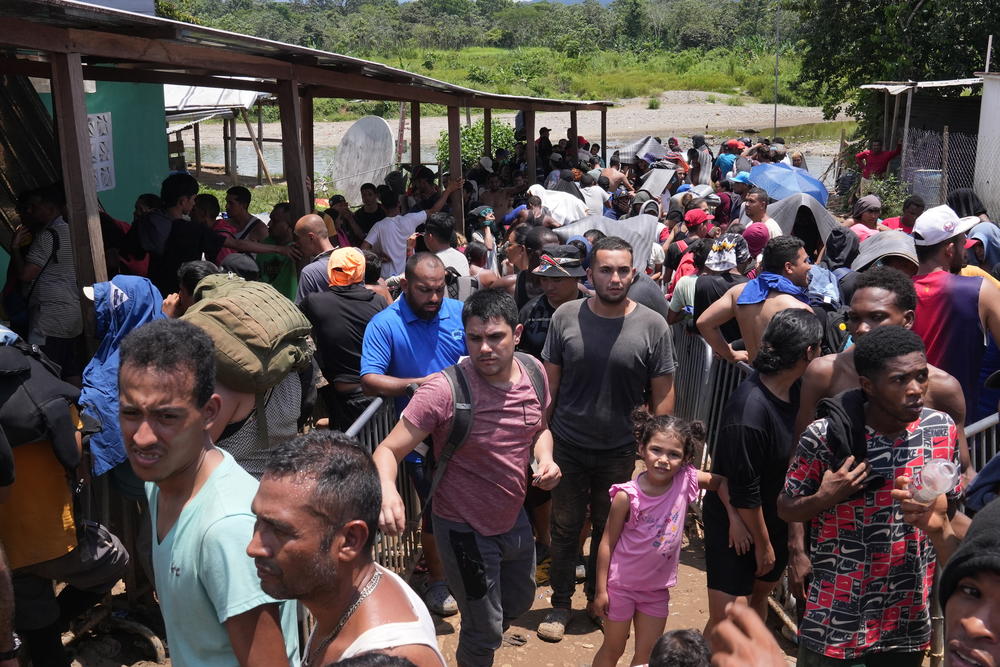Section Branding
Header Content
A record 400K migrants have crossed the treacherous Darién jungle to reach the U.S.
Primary Content
BAJO CHIQUITO, Panama — Bajo Chiquito is a small Indigenous village built along a river. It's the first place that U.S.-bound migrants reach in Panama, after making the hazardous trek across the Darién jungle.
Here hundreds of people stand in long lines under the blazing sun, as they wait to register with Panamanian immigration officers who enter everyone's names on computers.
The migrants are exhausted and dehydrated after walking across the rainforest for several days. But the officers in Bajo Chiquito only have three laptops to process the large crowds. And while almost everyone here is allowed into Panama for a few days, many complain about the wait.
"This is horrible," said Valeria Aponte, a Venezuelan migrant who had been in line for two days. Like most people here, she had no intention of staying in Panama. She was headed to the United States. "There are no numbers, or anything, and if we leave the line we will lose our spot," Aponte said, while crouching on the ground because she was exhausted from standing.
The Darién Gap, the treacherous stretch of roadless jungle that stands between South America and Central America, is once again experiencing a rise in the number of crossings.
Despite a U.S.-backed deal with Colombia and Panama to "end the illicit movement" along this route, numbers of migrants traversing the jungle's trails have spiked to an all-time high. In the first nine months of this year, 400,000 migrants have crossed the Darién on their way to the United States, Panamanian officials recently said, a sharp increase from the nearly 250,000 people who made the journey in all of 2022.
The large number of crossings has created a humanitarian crisis that governments in the region are struggling to cope with. Panama has described the situation as a threat to its national security. And farther to the north, neighboring Costa Rica has declared a state of emergency as thousands of migrants in poor health and without money get stranded in its border towns.
About a quarter of those making the journey are children, according to UNICEF. And criminals often rob migrants at gunpoint along the way.
Doctors Without Borders, a group that is assisting migrants as they emerge from the jungle, says that in the first six months of this year it treated 216 women and girls who were sexually assaulted on the route. Meanwhile, Panamanian health workers say they are overwhelmed with the arrivals.
"I've treated pregnant women who are bleeding because they lost their babies on the route," said Ariel Garibaldi, a doctor who runs Bajo Chiquito's small public clinic. It consists of two rooms and a patio that serves as a waiting area. "There are also many people with stomach illnesses who have really bad cramps, and even folks who have been attacked by African bees."
He added that some people have fainted while waiting in line to get registered by Panamanian officials, due to the dehydration and extreme heat.
"It can be very tough on some days, because we run out of medicines" like painkillers and antibiotics, he said.
It can take anywhere from three days to a week to cross the Darién Gap. Last year, at least 140 people perished along the way, according to the International Organization for Migration — with some drowning as they camped along rivers that can swell at night.
But thousands of migrants from South America, Africa and Asia are making the dangerous journey, as they try to escape poverty and violence in their home countries, or seek a better quality of life.
Delvis Davila, a welder from Venezuela, said he had been living in Chile for four years, but could barely cover food and rent with his salary, while sending about $100 a month to his daughters, who are residing in Colombia. So after returning to Venezuela for a few months, he set out on the long, overland journey to the United States.
"In the United States your work bears more fruits," said Davila, who is 36. He said it took four days to make the trek with a group of friends, after paying guides $250 per person on the Colombian side of the Darién to lead them to the Panamanian border.
He saw eight corpses of migrants along the way. "I don't wish this journey upon anyone," Davila said.
Venezuelans make up about 55% of the migrants who have crossed the Darién jungle this year, followed by Ecuadorians and Haitians, according to Panama's National Immigration Department. Many of the Venezuelans who are making the journey are on the move for the second or third time, after struggling to rebuild their lives in other South American countries.
"With my wife we had bought equipment to start a business," said Douglas Muñoz, a Venezuelan migrant who had been living in Ecuador for three years. "But then the economy slowed down and gangs began to ask for extortion payments. It was becoming just as bad as Venezuela."
Some human rights workers say that the policies of the U.S. and Mexico are increasingly forcing migrants into this route.
Juan Pappier, the Americas deputy director at Human Rights Watch, said that previously, Venezuelans and Ecuadorians who sought asylum in the United States, would take flights to Mexico, from where they would head to the U.S. border on buses.
That changed last year, when Mexico began to ask citizens of these countries for visas that are difficult for most migrants and asylum-seekers to get, a policy change that was made under pressure from the Biden administration.
"The migrants who took planes to Mexico to seek asylum in the United States are now forced or pushed to cross through this very dangerous jungle," Pappier said.
According to Panama's National Immigration Department, 130,000 people — mostly Cubans and Haitians — crossed the Darién in 2021. The number of crossings jumped to 248,000 in 2022, after it became harder for Venezuelans and Ecuadorians to skip the Darién jungle by taking flights to Mexico.
Pappier said that if safer routes are not found for migrants and refugees from South America, the number of people crossing the Darién will continue to rise.
"The situation in Venezuela continues to be dire. The situation in Haiti continues to deteriorate day by day. And the violence and crime in Ecuador is forcing many people to leave that country," Pappier said.
The Biden administration has tried to divert migrants away from the Darién jungle by opening three offices in Colombia in June, known as regional processing centers, where asylum-seekers from Venezuela, Cuba and Haiti can apply for permits that will enable them to fly to the U.S.
But the process to get appointments at these centers is slow. The program's website in Colombia stopped receiving applications for appointments in August after 29,000 people applied. According to data published by the State Department's Bureau of Population, Refugees and Migration, 411 people from Cuba, Venezuela and Haiti, were admitted into to the U.S. as refugees in July and August.
Meanwhile, around 2,000 people continue to pass through the village of Bajo Chiquito each day. After they register with officials, they catch small boats that take them to Lajas Blancas, a camp run by Panama's government. There, they line up for hours for buses that take them toward the border with Costa Rica, the next country on the long road to the United States.
"We have to do our best for our families," said Davila. "I can't spend the rest of my life working for almost nothing."
Copyright 2023 NPR. To see more, visit https://www.npr.org.
